Have you ever visited someone who recently moved into a new place? There are usually one or two furnished rooms where you can sit and connect, while the rest are still littered with piles of untouched moving boxes. You don’t linger in those unfinished spaces. You gather where it feels lived in.
That’s what brand marketing can feel like today. The boxes? Those are the direct brand ads—functional, present and often overlooked until necessary. The rooms that are lived in are where the community gathers—that’s where creators thrive. When creators enter the space, they don’t just unpack the boxes. They bring personality, connection and people with them. Over time, they help turn a marketing plan into something that feels like home. I call this the “new house” effect. And for the first half of 2025, we’ve seen some strategies help brands move in faster than others. And the common thread? Letting creators lead.
Here are four influencer marketing strategies that are helping brands make themselves at home in today’s landscape:
Balancing Speed And Substance Through Short- And Long-Form Video
The long and short of it all: What lengths are winning? The answer is both. Video content is expected to make up 82% of global consumer internet traffic this year. And as video rises internet tides, in the social media pool, platforms are optimizing and incentivizing for longer watch times. This means creators are playing the long game, experimenting with multiformat content across platforms.
The appetite for long-form creator video content isn’t limited to social. Streaming platforms are eyeing creators in growth manoeuvres. For instance, Netflix is testing video podcast content with Ms. Rachel and Kill Tony standup specials. And speaking of streaming content, YouTube achieved a new platform record: two consecutive months with 12% of total TV watch time, according to Nielsen.
Key To Win: Marketers embracing both long- and short-form creator-led video are positioned to futureproof marketing strategies in the wake of economic headwinds.
Creator Commerce Is Having A Growth Spurt
Both the sun and consumer trends move east to west, and now, in the west, we have finally seen brighter days for creator commerce.
The global live commerce market size is projected to grow at a compound annual growth rate (CAGR) of 32% over the next five years. Currently, social media holds the largest market size for live commerce at 42.1%.
As 77% of companies have increased their influencer marketing spends this year, it’s only natural to expand efforts to commerce strategies. And according to a recent survey, over 9 in 10 U.S. marketers plan to promote creator partnerships across retail media networks in 2025. Creator content is no longer a one-off transaction but a consistent strategic engine to power and influence all stages of the purchase journey. Influencer strategies are expanding in the form of storefronts, affiliates, lives, retail media extensions, immersive retail experiences and unexpected collaborations, to name a few.
Why? As effective storytellers, creators invoke emotion and can influence purchase decisions with relevant and engaging recommendations. They are a trusted mediator for brands that are looking for ways to reach certain audiences.
Key To Win: Creator-led commerce is the engine of modern marketing.
Chasing Growth Where Others Aren’t
Once you’ve acquired most of the world as your user base, where do you go? Social media’s reach among the U.S. population is at least seemingly reaching a plateau.
And with TikTok’s uncertain future, Meta’s antitrust trial and Google’s monopoly ruling, this has opened an opportunity for less-adopted social platforms to capitalize. Platforms like Bluesky, Patreon and Substack are starting to see more adoption as users open-mindedly investigate other ways to connect. Creators are diversifying their presence across platforms to futureproof against platform volatility.
For brands looking to build a presence on emerging social platforms, please don’t ask your agency teams about running traditional paid ads. This is never something immediately available. Even Threads, which amassed 100 million signups in its first week of launch in 2023, just rolled out advertising in April (almost two years later).
Key To Win: While traditional paid advertising may not be an immediate option on emerging social platforms, the ability to pay a creator to post is.
Binge-Worthy Influence
I started writing about this back in September, and the convergence of brands and creator upfronts is finally coming to fruition. We know a few things to be true: that younger people prefer creator-led content over premium TV and movies, that the streaming platforms are under pressure to win original content (and, therefore, attention), and, finally, brands are sponsoring episodic content.
Most recently, Vimeo opened the ability for creators to launch their own subscription streaming service.
These shifts in culmination have created a new opportunity for creators to pitch themselves to brands and create deeper, more lucrative partnerships. We are now inevitably seeing formal creator upfronts following the Forbes inaugural Creator Upfront last October. Companies like Spotter and LTK are following suit and hosting formal Creator Upfronts during the time of year when brands are looking to commit video ad dollars.
Key To Win: Cultivating longer-term creator partnerships is mutually beneficial to the brand and the creator, promoting speed to market, higher quality content and upleveled innovation.
Whether you are just starting to unpack or have fully moved in, these strategies offer a blueprint to help transform the box-filled spaces into inviting spaces or homes for communities to dwell and connect.
Feature Image Credit: Getty
By Kristen Dolan
Kristen Dolan is SVP of Growth at Influential. Read Kristen Dolan’s full executive profile here. Find Kristen Dolan on LinkedIn. Visit Kristen’s website.

